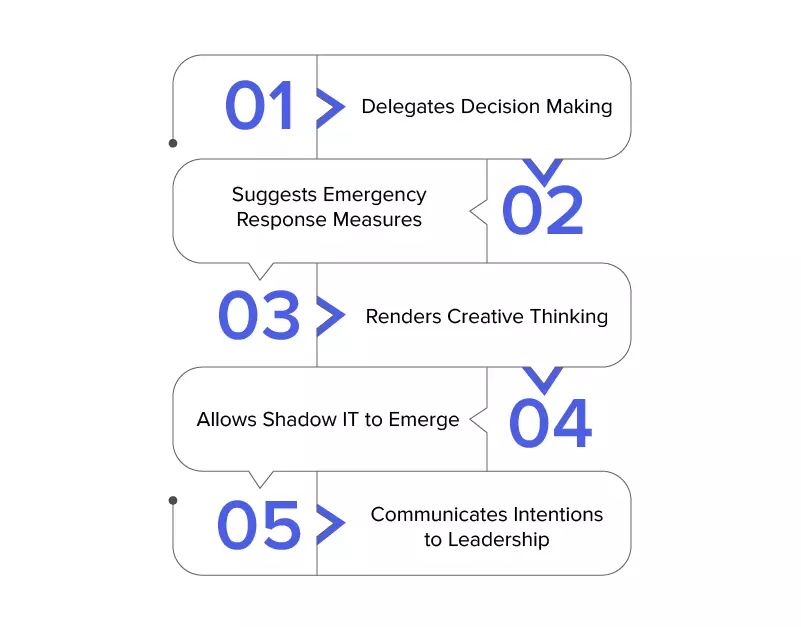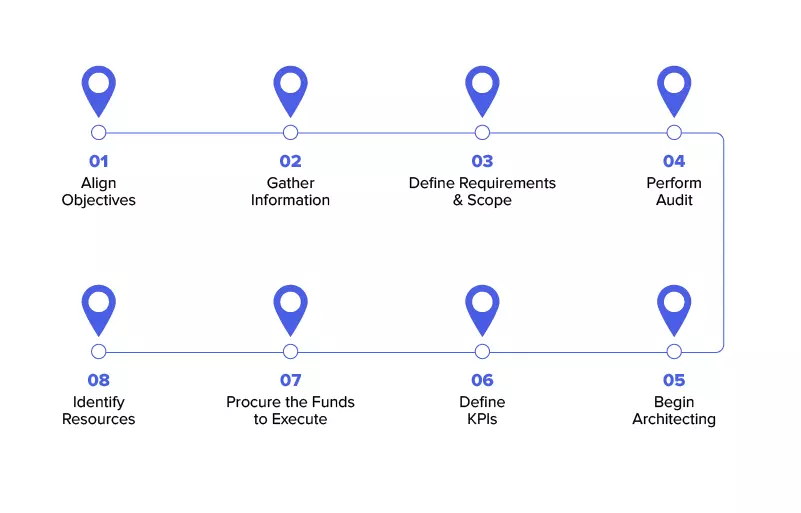- What is an IT Strategy?
- It is Strategic
- It is Dynamic
- It is Top-Down Inclusive
- Benefits of an IT Strategy
- Delegates Decision Making
- Suggests Emergency Response Measures
- Renders Creative Thinking
- Allows Shadow IT to Emerge
- Communicates Intentions to Leadership
- How to Create an IT Strategy for Business?
- Start with the Top IT Strategy for Business: Align Objectives
- Gather Information
- Define Requirements & Scope
- Perform Audit
- Begin Architecting
- Define KPIs
- Procure the Funds to Execute
- Identify Resources
- Appinventiv - IT Advisory Made Easy
- FAQs
Back in the day, a common KPI of IT managers used to be to create and implement an effective IT strategy for business. But with the coming of age of digital business transformation, promoting an actionable IT strategy has become the responsibility of the collective C-suit. We find ourselves in such a position because an organization’s success critically depends on how streamlined its IT operations are.
Therefore, in this article we’ll be focusing on what is an IT strategy framework, benefits of an IT strategy, and ways to work out IT strategy development.
Let’s get to it then.
What is an IT Strategy?
IT strategy and planning is a method of competitively incorporating the necessary IT infrastructure that allows employee productivity, products, and services to be at industry standard. In other words, it helps a business create organizational value. While working on streamlining your IT strategy and business strategy, the goal should be to get clear insights on:
The changes required to align IT with the business’ vision and mission.
Having an IT strategy for business lets you gauge a macroeconomic view of the important steps needed to be taken to reach sustainable profitability. A few characteristics of a well thought-out strategy are:
It is Strategic
Strategic planning aids stakeholders to construct meaningful value for the business. It evaluates the vision for IT so that the long-term goals of the enterprise are met while augmenting IT capability. IT strategy development is concerned with enhancing the IT process, infrastructure, and functioning. Do note, that a concrete IT strategy will not be tactical. Tactical plans are those that can change over the course of time to adapt to market needs. But strategies don’t witness as many changes as they are built to last.
It is Dynamic
Creating an IT strategy for a small business or a large enterprise is not a one-time act. Instead, it plays out over time and is retrofitted with modifications to accommodate technological shifts. You should develop a best practice to revisit your IT strategy framework annually. Your IT infrastructure strategy should leave enough leg-room for version updates and must be flexible enough to account for changes in the marketplace. Such efforts to stay future-ready would help streamline your digital transformation needs in line with your mission statement.
It is Top-Down Inclusive
Your IT infrastructure strategy should not be restricted to the upper managerial layers but flow evenly through the lower ranks of the corporate bureaucracy. It should be shareable and understandable for the top, bottom, and frontlines so employees don’t feel disengaged.
Benefits of an IT Strategy
By now, it should be clear that having a requisite IT strategy lends a defined, directional flow to your everyday operations. In a way, it is a risk mitigation process that aims to highlight improvement areas for enterprise IT.
Whether it is due to a lack of manpower, aspirations, or finances, an IT roadmap is the bridge that connects organizational goals to outcomes. Therefore, in this section, we will go through the various benefits that a fool-proof IT infrastructure system represents. This will help clearly explain the need for businesses to seek the guidance of an IT consulting firm.
Delegates Decision Making
If you’re a manager, you know how difficult it is to assign a certain responsibility to team members. If things go south, so do your judgemental faculties. For instance, no matter how promising a plan you have conjured, it is a tedious process to get people to be on the same page.
A thoughtful IT strategy for small businesses or large organizations does away with instinctive decision-making. For instance, if team members are in a quandary to reach a consensus, they can refer to the guidelines of IT strategy and planning. In this manner, teams would be able to make out the what, why, and how of their actions. As a result, managerial oversight is reduced, individual accountability is increased proportionately and decision-making is flatlined amongst contributing parties.
Suggests Emergency Response Measures
Strategic planning assists organizations in two ways:
- It helps in creating a roadmap to set out and achieve milestones for IT betterment. It prioritizes planning based on the vision of the company.
- An IT strategy for business allows teams to be well-prepared for unforeseen changes. While they do promote growth, they are equally helpful in tackling unexpected situations.
An IT strategy example could be that your in-house file storage space reaches peak capacity and your IT strategy for business suggests migrating to cloud storage. Typical frameworks include space for pilot projects.
Renders Creative Thinking
Advance IT planning is the fodder you need to get the business machine to milk money. Once you have an apparatus in place you can reach actionable conclusions about how to proceed or why to proceed or in which direction to proceed.
Allows Shadow IT to Emerge
Now, what is shadow IT? Simply put, these are departments whose capabilities overlap but don’t entirely coincide with the official IT department. In legacy enterprises, shadow IT surfaces as a result of the flexibility constructs of age-old IT enterprises. Strategic IT planning allows an organization to explore areas where shadow IT can set foot and spread out.
Communicates Intentions to Leadership
IT planning can help managerial overlords convey their intentions to senior leadership. Top-level strategy is what veteran corporate leaders are most concerned about in organizations. A documented plan lets such corporate bureaucrats have productive conversations with all. The exercise allows for course correction in case any deviation occurs.
How to Create an IT Strategy for Business?
Creating an IT strategy is a gargantuan undertaking wherein you need multiple cogs to be operating in synergy in one place. There are 4 components that help define an enterprise’s IT capabilities, namely, IT strategy, IT Processes, IT Management, and IT Infrastructure.
But not delving into specifics here, a strategic IT vision statement is an end-to-end document that lists actionable inputs to augment a business’ IT prowess. For the uninitiated, we’ll briefly take you through how this document is created ground-up.
There are 8 essential steps involved in creating an IT strategy:
Start with the Top IT Strategy for Business: Align Objectives
IT strategies are meant to address and align the day-to-day undertakings of an organization towards broad view goals. It is therefore essential to have an understanding of the KPIs of all departments so the plan is both inclusive and holistic. Each business division has to be brought on the same page as the strategic framework demands of them.
Gather Information
Study competitors while also surveying experts on the specifications for an ideal framework. Have high-level conversations in the c-suite to understand their viewpoints and finetune the IT strategy accordingly.
Define Requirements & Scope
After ensuring you have sufficient information, define the timeline of your IT strategy, for instance, is your framework designed with a 5-year vision, or 10-year vision. Note that the process should be fragmented into shorter timelines that can be reviewed periodically to track progress.
Perform Audit
You need to take stock of your hardware/software capabilities to understand the level of disruptions that ought to be brought about. What you’re after is cost-efficiency. Factor in the current technological pedigree of your workforce as well. Are they competent to migrate onto newer, trending toolkits or will they need orientation?
Begin Architecting
So by now, you should have your plans and milestones set ahead of you. The next step is to create the architectural layout that would help you achieve your IT strategy. This includes resources like software, hardware, and the manpower required to operate such tools.
Define KPIs
There has to be a yardstick for everything so you can measure your progress on a quarterly basis. This is encapsulated in the Key Performance Indicators. These could include employee/customer satisfaction, marketing ROI, capital expenditure, service level indicators, etc.
Procure the Funds to Execute
All said and done, you cannot move the needle unless you have the funds to purchase the requisite line items. And that wouldn’t transpire, as indicated earlier until the leadership has your back. Therefore, get c-suit hotshots on your side after closing the legal contingencies and begin marching towards IT optimization.
Identify Resources
Often, an organization’s IT resources are hired and distributed keeping in mind the ongoing projects. Therefore, even before the long-term IT strategy framework gets implemented, it’s vital to identify the resources that continue to nudge such an undertaking towards completion. If your venture lacks the corporate slash manpower wherewithal to get going, then consider making contact with a reputed IT consulting service company.
Appinventiv – IT Advisory Made Easy
Appinventiv can help you find your inner calling when it comes to technology and finding the right IT strategy for business. With an enviable list of clientele that includes IKEA, Domino’s, KPMG, Adidas, and Pizza Hut (just to name a few), we have the crystal ball to predict your business needs. From IT consulting services to complete digital transformation, we offer everything under one roof to make your IT smarter than it has ever been. Get in touch to see how we can take your IT strategy to the next level.
FAQs
Q. Why is IT strategy for business vital?
A. IT strategy is the broad plan and strategy that businesses create to match their information technology capabilities with their overarching business goals. It entails figuring out how to use technology to strengthen operations, encourage innovation, increase production, and acquire a competitive edge.
IT strategy covers a range of topics, including network systems, cybersecurity, data management, and programs for digital transformation. An organization’s ability to prioritize objectives, distribute resources effectively, reduce risks, and improve IT operations is all made possible by a clearly defined IT strategy.
Q. How do companies create a successful IT strategy for business?
A. It takes a systematic and team effort to create an effective IT strategy for business. Here are some crucial actions to think about:
- Recognize company objectives
- Analyze your present IT skills
- Set strategic objectives
- Analyze the technology gap
- Set initiatives’ priorities
- Create a roadmap for implementation
- Engage stakeholders
- Constantly evaluate and adjust
Q. What are the potential benefits of a well-planned IT strategy for business?
A. Businesses can gain a variety of advantages from implementing a well-designed IT strategy, including:
- Enhanced operational effectiveness
- Improved client experience
- Advantage over rivals
- Cost reduction
- Risk reduction
- Flexibility and scalability


IT Infrastructure Software Development - The Why's and How's
In today's age of digital transformation, where businesses increasingly rely on technology to drive efficiency and innovation, the role of IT infrastructure has become more critical than ever. At the heart of this infrastructure lies software development – a dynamic process that enables organizations to build, deploy, and manage the software systems that power their…

IT Compliance Regulations for Industries in the US - Ensuring Your Business is IT Compliant
Data security has been universally accepted as one of the foundational elements of business success. Influenced by digitalization and global connectivity reaching their zenith, it has become critical for companies to keep their and users’ data extremely secure. To ensure that businesses don't fail in the process, several regulatory bodies have come to the forefront…










